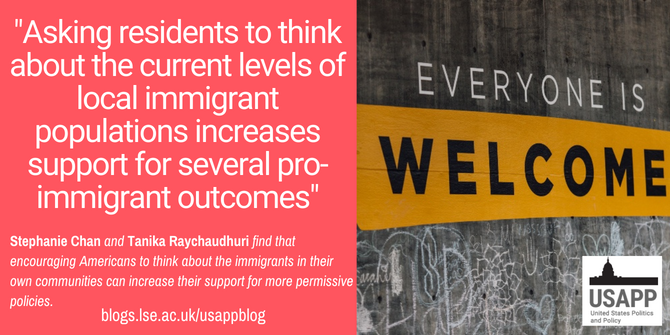
 Immigration in the United States is a divisive issue, with policy views often splitting across party lines. While debates about immigration tend to be national ones, most Americans’ experience of immigration is local. In new research, Stephanie Chan and Tanika Raychaudhuri, along with Ali Valenzuela, examine how framings about immigration at the local level can affect how Americans feel about immigration. They find that when asked to think about the immigrant population in their local community, Americans were more likely to support more favorable policies towards immigrants. These feelings may also be supported by positive interactions with immigrants where they live.
Immigration in the United States is a divisive issue, with policy views often splitting across party lines. While debates about immigration tend to be national ones, most Americans’ experience of immigration is local. In new research, Stephanie Chan and Tanika Raychaudhuri, along with Ali Valenzuela, examine how framings about immigration at the local level can affect how Americans feel about immigration. They find that when asked to think about the immigrant population in their local community, Americans were more likely to support more favorable policies towards immigrants. These feelings may also be supported by positive interactions with immigrants where they live.
Immigration is at the center of policy debates in contemporary American politics. It is also one of the most polarizing political issues in the United States, with increasingly stark divisions across party lines. To offer one example, a recent survey finds that 46 percent of Democrats but only 17 percent of Republicans believe it is very important to “establish a way for immigrants who came here illegally to stay.” In contrast, 70 percent of Republicans and 15 percent of Democrats believe it is “very important to increase security along the U.S.-Mexico border.” Although many political debates about immigration occur on the national level, most Americans experience the impact of immigration locally.
How do community-based frames – or how people approach an important issue – of immigration shape public opinion about immigration policy? This is an important question to consider against the backdrop of increasingly negative frames of immigrants in the national news media. The media often frames immigration negatively, stereotyping immigrants as people who break the law, drain local resources, and rely on social welfare. These images may stand in contrast to the experiences ordinary citizens have when they interact with immigrants in their local community. This suggests that actual contact with immigrants in daily life may counter these narratives.
How do local community frames of immigration affect Americans’ attitudes?
To explore this possibility, we, along with Ali Valenzuela of American University, analyze the impact of local community frames of immigration on the American public’s policy views. Framing immigration in relation to individual’s experiences with immigrants in their closest local environments generally increases American’s support for more permissive policies. Notably, this effect holds across party lines, and is larger for Republicans than Democrats, who are more likely to support permissive immigration policies to begin with. However, not all local community frames are equally powerful. Frames that focus on current immigrant population levels rather than recent changes in the immigrant population can influence Americans’ policy views.
While prior research examines the impact of contact with immigrants on public opinion, these studies usually look at the relationship between the number of immigrants in an individual’s area of residence and their attitudes towards immigrants. These studies have mixed results. While some scholars find discovering that support for immigration increases with number of immigrants in a local community, others find the opposite.
An important caveat to these studies is that Americans are not very good at estimating how many immigrants live in their communities. Americans’ estimates of how many immigrants there are in their local community does not track very closely with official statistics. This suggests that objective estimates of local immigrant population levels are not as helpful in predicting public opinion on immigration as people’s subjective perceptions of those populations. As a result, prior research studying the relationship between the number of immigrants in a community and opinions on immigration misses a crucial factor: how Americans perceive immigrants in their local community.
Focusing on immigrant populations in local communities
Rather than using the actual numbers of immigrants in an area, we asked Americans to think about the immigrant populations in their local community, randomizing whether they received a message asking them to consider the size of the current immigrant population in their locality, recent changes in the immigrant population in their locality, or no message at all. We found that asking Americans to consider the current size of the immigrant population where they live makes them more likely to support some policies that are favorable to immigrants.

Photo by Katie Moum on Unsplash
Although Americans’ opinions on immigration are sharply divided across party lines, local community frames of immigration increase support for permissive policies among a range of subgroups of Americans, including those who are not supportive of immigration. Most notably, despite general opposition to such policies, Republicans’ support for permissive immigration policies increases when they are reminded of the immigrants in their local community. While Republicans are less likely than Democrats to support such policies to begin with, when Republicans are reminded of the immigrants in their local communities, they are less likely to believe that sanctuary cities – cities which are more supportive of immigrants in their policies – obstruct federal immigration investigations and to oppose restrictions on immigration compared to Republicans who did not receive this message.
Contact may increase support for more permissive immigration policies
Open-ended responses to our survey offer some evidence that these changes in immigration policy views come from actual contact with immigrants within local communities. When asked how the local immigrant population makes them feel, many respondents wrote about the cultural benefits of diversity as well as the economic benefits of having immigrants in the local community. For example, one person wrote that, “I work with legal immigrants every day, most from Asian and Middle East countries. This does not bother me at all. They are educated and bring valuable skills, pay taxes, and bring a different culture while assimilating into the US culture.” Another respondent highlights the cultural benefit of immigrants in their community, stating “[t]he cultural enrichment brought by immigrants is vital to a community” and they “enjoy the diversity in the community, it enriched our communities, I especially enjoy the Hispanic cultures, they are a rich warm culture and bring much to our communities!” While more research is needed to examine this connection, these quotes provide some preliminary evidence that being reminded of the immigrants in local communities makes Americans more likely to support permissive policies.
This research suggests that exposure to immigrant populations does not uniformly lead to backlash. To the contrary, asking residents to think about the current levels of local immigrant populations increases support for several pro-immigrant outcomes. Immigration has long been a divisive issue in American public opinion, which has significant implications not only for policy, but also for national identity. Encouraging Americans to think about immigration as a local rather than a national issue may shape opinions about immigration policy.
- This article is based on the paper, ‘Perceived Local Population Dynamics and Immigration Policy Views’, in American Politics Research.
- Please read our comments policy before commenting.
- Note: This article gives the views of the author, and not the position of USAPP – American Politics and Policy, nor the London School of Economics.
- Shortened URL for this post: https://bit.ly/3DpTGv4






